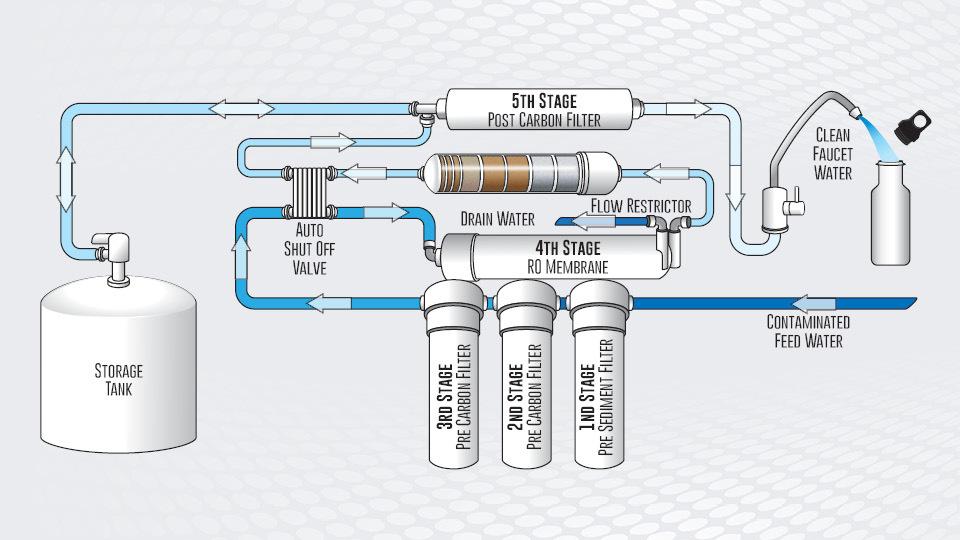Storage Tanks vs. Tankless Reverse Osmosis Systems: What's the Difference?
Reverse osmosis (RO) systems are a very popular choice for home water filtration and there are two main types of under sink RO systems: those with a tank and tankless.
What is the difference between a tankless RO system and a system with a storage tank?
While the presence of a tank does not sound like much, the implications are far-reaching and affect many other aspects of system design and performance.
Each system design offers distinct advantages over the other, depending on your water usage and needs.
RELATED:What is Reverse Osmosis & How Does it Work?
Under Sink Reverse Osmosis Water Filters
Point-of-use (POU) under sink RO water filtration systems have been around for decades and are one of the most popular ways to filter 90% or more contaminants out of a high volume of tap water in the home.
When it comes to under sink RO water filtration, there are two main types of systems: those that use post-filtration storage tanks and those that do not.
The latter option is fairly new and called "tankless" — a term that may seem counterintuitive but comes from the fact that the traditional RO system design always includes a storage tank.
In addition to the RO membrane, complete RO systems come with additional stages, including sediment, granular activated carbon (GAC), and polishing filters to remove most contaminants, colors, and odors from tap water.
The installation of any RO system requires you to connect the system (a preconfigured series of various filters, including a RO membrane) to the cold water line under your sink. A wastewater line is connected to the drain pipe and a dedicated faucet is installed on the countertop alongside the standard faucet.
The system processes tap water through the various filters, produces some wastewater (as is required to maintain the RO membrane and flush impurities), and then delivers the purified water for drinking or cooking through the filtered water faucet.

With additional hoses and connectors, you can also run filtered water from an RO system to your refrigerator, ice maker or coffee machine.
Maintenance is a simple matter of changing out filters either as needed (by way of periodic water testing) or on the schedule recommended by the manufacturer, usually six to 12 month intervals.
AdvertisementStorage Tank RO Systems
Traditionally, all RO systems came with a pressurized storage tank.
The typical under sink storage tank is a 3.2-gallon metal canister with a pressurized rubber bladder inside to hold the water.
The storage tank is required because RO is an inefficient process. Even with adequate water pressure feeding the system, the flow rate of filtering water is much slower than that of tap water directly from the plumbing.
RO systems with a tank will continuously process filtered water into the storage tank until the tank is full.
When filtered water is needed at the dedicated faucet, it is delivered directly from the storage tank at a higher pressure than the filters could provide in real-time. As the tank is drained to a certain threshold, it triggers the filters to process water and refill the tank.
The benefits of this system design are obvious:
Tankless Reverse Osmosis Systems
In recent years, "tankless" RO systems have become popular for several reasons. So how does a tankless system differ?
Since there is no storage tank, tankless systems include a powered internal pump that creates ideal pressure for more efficient water processing and nearly endless, steady water output. As soon as you turn on the dedicated faucet, water is immediately processed on-demand and then sent directly to the faucet.
The big benefits here are:
AdvertisementComparing the Options
While both types of RO systems produce exceptionally clean and pure water, what are the real-world implications of choosing one over the other?
Which Reverse Osmosis System Should You Choose?
Reverse osmosis is considered by many to be the best POU water filtration option in homes and small businesses because of its relatively low cost, speed, efficiency, and excellent water filtering capabilities. Choosing either a tank or tankless option will provide all the benefits of cleaner, healthier water for those looking to reduce exposure to chemicals and contaminants from their tap. The choice comes down to a comparison of features and benefits with your needs and water consumption habits.
Conclusion
If you are considering purchasing a traditional or tankless reverse osmosis water filtration system, it is important to know the differences between these two types.
While the main difference revolves around how they store and deliver filtered water, this leads to the list of key differences in features and performance discussed above.
When choosing a water purifier for your home, be sure to ask yourself which features are most important so you can make an informed decision about which system is best suited for you.








